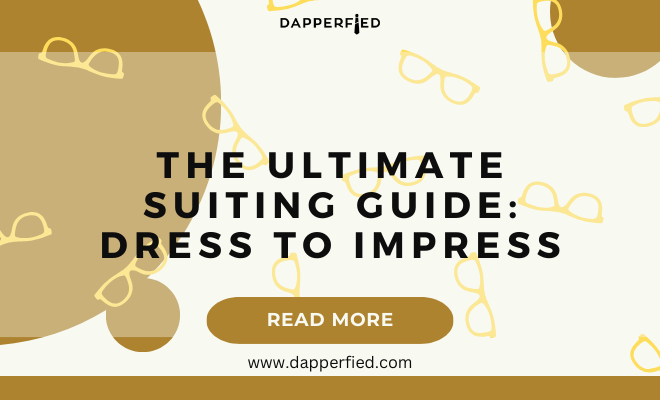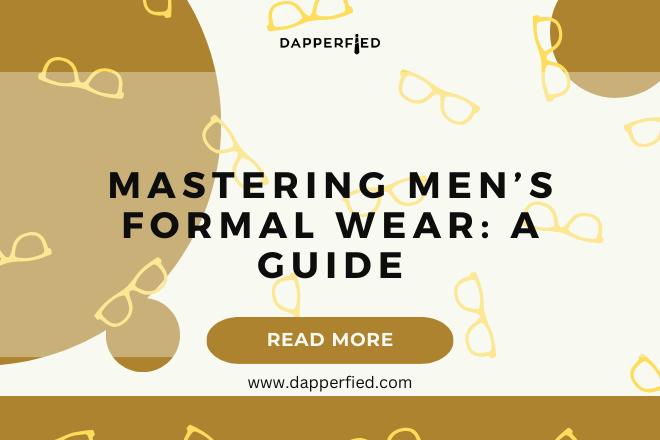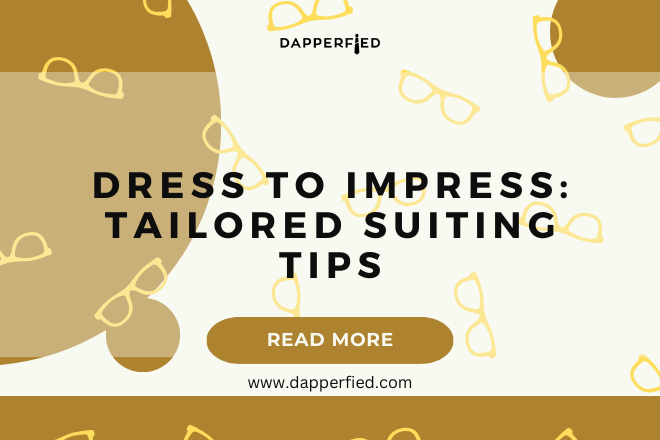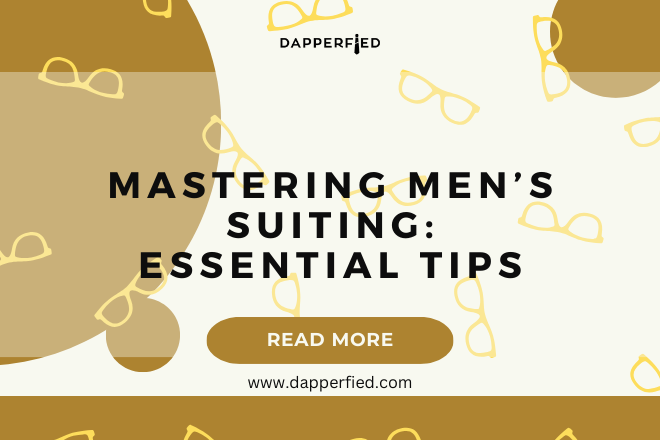
Men's Style
The Ultimate Suiting Guide: Dress to Impress
In today’s society, the way we present ourselves plays a significant role in how we are perceived by others. Whether it’s for a job interview, a special occasion, or just everyday life, dressing well can make a lasting impression and boost our confidence. When we dress to impress, we show that we care about ourselves and the image we project to the world. It’s not just about looking good; it’s about feeling good and exuding confidence.
When we dress well, we feel more put together and ready to take on the world. It gives us a sense of self-assurance and can even improve our mood. Studies have shown that when we dress in clothes that make us feel good, our self-esteem and overall happiness increase. Dressing well also shows respect for ourselves and those around us. It demonstrates that we take pride in our appearance and value the impression we make on others.
Key Takeaways
- Dressing to impress can have a significant impact on how others perceive you.
- Choosing the right suit involves considering factors such as fit, fabric, and style.
- There are various types of suits, including single-breasted, double-breasted, and tuxedos.
- Getting the perfect fit for a tailored suit involves taking accurate measurements and considering your body type.
- When purchasing a suit, it’s important to look for quality materials, construction, and details.
Suit Selection Tips: How to Choose the Right Suit for You
When it comes to choosing the right suit, there are several factors to consider. First and foremost, it’s important to understand the occasion and dress code. Different events call for different types of suits, so it’s essential to dress appropriately. For formal events such as weddings or black-tie affairs, a tuxedo may be required, while business meetings or interviews may call for a more traditional suit.
Next, consider the fabric and color of the suit. The fabric should be comfortable and appropriate for the season. Wool is a popular choice for suits as it is breathable and durable. As for color, navy and charcoal gray are versatile options that can be worn for various occasions. However, if you’re feeling bold, you can opt for a suit in a different color or pattern to make a statement.
Lastly, finding the right fit is crucial. A well-fitted suit can make all the difference in how you look and feel. The jacket should fit snugly but not be too tight, with the shoulders aligning with your own. The sleeves should end at the base of your thumb, and there should be enough room to move comfortably. The pants should sit at your natural waist and have a slight break at the shoes. If necessary, consider getting the suit tailored to ensure a perfect fit.
Men’s Suiting Styles: Understanding the Different Types of Suits
When it comes to men’s suiting styles, there are various options to choose from. One of the main distinctions is between single-breasted and double-breasted suits. Single-breasted suits are more common and versatile, with a single row of buttons down the front. They can be worn for both formal and casual occasions. On the other hand, double-breasted suits have two rows of buttons and are typically more formal.
Another aspect to consider is the lapel style. There are three main types: notch lapels, peak lapels, and shawl lapels. Notch lapels are the most common and versatile, featuring a triangular notch where the lapel meets the collar. Peak lapels have pointed edges that extend upward toward the shoulder, giving a more formal and elegant look. Shawl lapels are rounded and do not have any points or notches.
Lastly, there are different types of pockets on a suit jacket. The most common is the flap pocket, which has a flap that covers the opening. This is a classic and versatile option. Another option is the welt pocket, which has a small opening without a flap. This gives a more streamlined and modern look. Additionally, some suits may have a ticket pocket, which is a smaller pocket above one of the main pockets.
Tailored Suit Guide: How to Get the Perfect Fit
| Measurement | Ideal Range | Acceptable Range |
|---|---|---|
| Chest | 36-40 inches | 34-42 inches |
| Waist | 30-34 inches | 28-36 inches |
| Hip | 36-40 inches | 34-42 inches |
| Shoulder | 17-19 inches | 16-20 inches |
| Sleeve Length | 32-34 inches | 30-36 inches |
| Pant Length | 30-32 inches | 28-34 inches |
| Thigh | 22-24 inches | 20-26 inches |
| Inseam | 30-32 inches | 28-34 inches |
A well-fitted suit is essential for looking sharp and put together. It can make even an off-the-rack suit look like it was made just for you. Finding a good tailor is key to achieving the perfect fit. They can make adjustments to the suit to ensure it flatters your body shape and fits you like a glove.
When it comes to tailoring a suit, there are several areas that can be adjusted. The jacket sleeves can be shortened or lengthened to the appropriate length, and the waist can be taken in or let out for a better fit. The jacket length can also be altered if necessary. For the pants, the waist and seat can be adjusted, as well as the length and taper of the legs.
It’s important to communicate with your tailor and let them know exactly what adjustments you want. They are professionals and can offer guidance on what changes will work best for your body type. Remember, a well-fitted suit will not only look better but also feel more comfortable, allowing you to move with ease.
Suit Buying Tips: What to Look for When Purchasing a Suit
When buying a suit, it’s important to set a budget and stick to it. Suits can range in price from affordable options to high-end designer brands. Determine how much you are willing to spend and look for suits within that price range. Keep in mind that quality is more important than brand name, so focus on finding a suit that is well-made and fits you properly.
When it comes to quality, there are several things to look for. First, check the fabric and construction of the suit. Look for suits made from high-quality materials such as wool or a wool blend. The stitching should be neat and even, with no loose threads or puckering. Pay attention to details such as the lining, buttons, and zippers, as these can indicate the overall quality of the suit.
Deciding whether to shop for a suit online or in-store is a personal preference. Online shopping offers convenience and a wider range of options, but it can be challenging to determine the fit and quality without trying the suit on. In-store shopping allows you to see and feel the suit in person, but the selection may be more limited. If you choose to shop online, make sure to check the return policy in case the suit doesn’t fit or meet your expectations.
Men’s Formal Wear: Beyond the Basic Suit


While a well-fitted suit is a staple in any man’s wardrobe, there are occasions that call for more formal attire. Tuxedos are typically worn for black-tie events and require a different level of sophistication. A tuxedo consists of a black or midnight blue jacket with satin lapels, matching trousers with a satin stripe, a white dress shirt, and a black bow tie. It’s important to follow the specific dress code for black-tie events to ensure you are appropriately dressed.
For summer weddings or outdoor events, dressing appropriately while staying cool is key. Opt for lighter fabrics such as linen or cotton, which are breathable and lightweight. Lighter colors such as tan or light gray can also help reflect the sun’s rays and keep you cooler. Pair your suit with a light-colored dress shirt and a patterned tie for a stylish and summery look.
Beach weddings call for a more relaxed and casual attire. Instead of a traditional suit, consider wearing a linen or seersucker suit in light colors such as white or pastels. Pair it with a lightweight dress shirt in a complementary color and skip the tie for a more laid-back look. Don’t forget to wear comfortable shoes that can handle sand or grass.
Dress Shirts and Ties: The Perfect Complement to Your Suit
Choosing the right dress shirt is just as important as selecting the right suit. The shirt should complement the suit in terms of color and style. A classic white dress shirt is a versatile option that can be worn with any suit. It’s crisp, clean, and timeless. However, don’t be afraid to experiment with different colors and patterns to add some personality to your look.
When it comes to ties, the general rule is to choose a tie that is darker than your shirt and lighter than your suit. This creates a nice contrast and ensures that the tie stands out without overpowering the overall look. Solid-colored ties are a safe choice and can be paired with patterned shirts or suits. If you’re feeling more adventurous, try a patterned tie with a solid-colored shirt or suit for a bold and stylish look.
Different tie knots can also add variety to your outfit. The most common knot is the four-in-hand knot, which is simple and versatile. The half-Windsor knot is slightly larger and more symmetrical, while the full Windsor knot is larger and more formal. Experiment with different knots to find the one that suits your style and complements your suit.
Accessorizing Your Suit: Shoes, Belts, and Pocket Squares
Accessorizing your suit can elevate your look and add a touch of personal style. When it comes to shoes, choose a pair that complements the color and style of your suit. Black or brown leather dress shoes are classic options that can be worn with any suit. Make sure they are clean and polished for a polished look.
Matching your belt to your shoes is a small detail that can make a big difference in your overall appearance. If you’re wearing black shoes, opt for a black belt, and if you’re wearing brown shoes, choose a brown belt. The belt should be made of high-quality leather and fit properly.
Adding a pocket square is another way to add flair to your suit. It’s a small accessory that can make a big impact. Choose a pocket square in a complementary color or pattern to your suit and fold it neatly into your jacket pocket. Experiment with different folds and styles to find the one that suits your taste.
Caring for Your Suit: Maintenance and Storage Tips
Taking care of your suit is essential to ensure it lasts and looks its best. Proper storage is key to maintaining the shape and structure of the suit. Hang your suit on a sturdy wooden or padded hanger to prevent wrinkles and maintain the shape of the shoulders. Avoid using wire hangers, as they can cause the suit to lose its shape.

When it comes to cleaning your suit, it’s best to follow the care instructions on the label. In general, suits should be dry cleaned sparingly, as frequent dry cleaning can cause the fabric to wear out faster. Instead, spot clean any stains and air out your suit after wearing it. If necessary, take it to a professional cleaner for a thorough cleaning.
To remove wrinkles from your suit, use a steamer or iron on a low heat setting. Hang the suit in a steamy bathroom for a few minutes to help release any wrinkles. If using an iron, place a clean cloth between the iron and the suit to prevent direct contact. Gently press the iron over the fabric, being careful not to apply too much pressure.
Putting It All Together for a Confident Look
Dressing well is not just about looking good; it’s about feeling good and exuding confidence. By following these tips for selecting, tailoring, and accessorizing your suit, you can create a look that is both stylish and personal. Remember to dress appropriately for the occasion, choose high-quality garments that fit well, and take care of your suit to ensure it lasts.
Don’t be afraid to experiment with different styles and colors to find what works best for you. Dressing well is an art form that allows you to express your personality and make a lasting impression. So go ahead, put on that well-fitted suit, accessorize with confidence, and step out into the world knowing that you look and feel your best.
If you’re looking to up your style game and master the art of suiting, then you definitely need to check out Dapperfied’s comprehensive Suiting Guide. However, if you’re interested in exploring the influence of popular culture on men’s fashion, you won’t want to miss their fascinating article on “12 Ways Mad Men Influenced Men’s Style.” From sharp tailored suits to sleek hairstyles, this show has left an indelible mark on modern menswear. So, whether you’re a fan of the hit TV series or simply curious about the impact of pop culture on fashion trends, this article is a must-read. Check it out here!
FAQs
What is a Suiting Guide?
A Suiting Guide is a comprehensive guide that provides information on how to choose, wear, and maintain a suit.
Why is it important to have a Suiting Guide?
A Suiting Guide is important because it helps individuals make informed decisions when choosing a suit. It also provides tips on how to wear and maintain a suit, ensuring that it lasts longer and looks great.
What are the different types of suits?
The different types of suits include single-breasted suits, double-breasted suits, three-piece suits, tuxedos, and blazers.
How do I choose the right suit for me?
To choose the right suit, you need to consider factors such as your body type, the occasion, and your personal style. It is also important to choose a suit that fits well and is made from high-quality materials.
What should I look for when buying a suit?
When buying a suit, you should look for factors such as the fit, the quality of the materials, the style, and the price. It is also important to consider the occasion and your personal style.
How do I take care of my suit?
To take care of your suit, you should store it properly, dry clean it when necessary, and avoid wearing it too often. You should also avoid exposing it to direct sunlight and heat, and avoid spilling liquids on it.

















